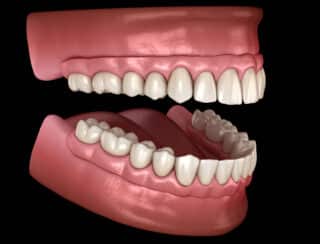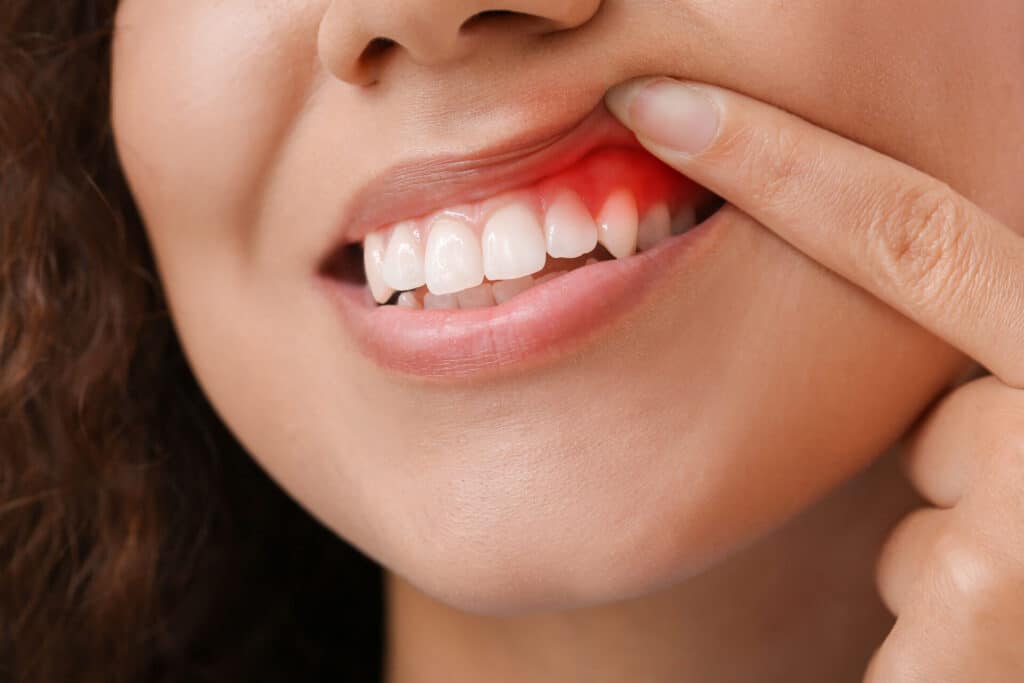
More Dental Health Articles
Gum Disease In Different Stages: Recognizing And Treating Gingivitis vs. Periodontitis

Gum disease, a common yet serious dental condition, affects a significant portion of the population at some point in their lives. It often starts with mild symptoms that can easily go unnoticed but can progress to severe stages, leading to significant oral and overall health issues if left untreated. Understanding the differences between the initial and advanced stages of gum disease, specifically gingivitis and periodontitis, is crucial for timely recognition and treatment.
This article explores the signs and treatments for gum disease.
Importance Of Professional Care
Before tackling the signs and treatments for gum disease, it’s essential to recognize the importance of professional care. Typically, professional dental care is essential at any stage of gum disease. Dentists and dental hygienists can provide personalized treatment plans and guidance for managing the condition effectively. Professional interventions can range from routine cleanings to more complex procedures, all aimed at halting the progression of the disease and restoring oral health.
Moreover, dental professionals can offer invaluable advice on preventive measures, helping patients maintain optimal oral hygiene and avoid future complications related to gum disease. For more information on treatments and preventive measures for gum disease, checking out reputable resources online would be an excellent idea to gain valuable insights.
Early Stage: Gingivitis
Gingivitis marks the initial phase of gum disease, characterized by gum inflammation. It’s primarily caused by the accumulation of plaque, a sticky film of bacteria that forms on teeth when starches and sugars in food interact with bacteria normally found in the mouth.
One of the common symptoms of gingivitis includes red, swollen gums that may bleed easily when brushing or flossing. The damage is reversible at this stage, and the gums can be returned to a healthy state with proper oral hygiene practices.

Recognizing Gingivitis
Knowing the early signs of gingivitis is crucial in halting the progression of gum disease and ensuring the health of the gums and teeth. Gingivitis, the initial stage of gum disease, is primarily marked by inflamed gums due to plaque buildup. Early intervention can reverse its effects, preserving the integrity of oral health.
The signs to watch for include:
- Redness and Swelling: Healthy gums are firm and pale pink. If they appear red, puffy, or swollen, it could indicate gingivitis.
- Bleeding: Gums that bleed during routine brushing or flossing are a common sign of gingivitis, suggesting that the gums are inflamed and sensitive.
- Halitosis: Persistent bad breath or a lingering bad taste in the mouth can be a sign of gingivitis, often caused by bacteria present in plaque and tartar.
- Gum Recession: Gums that pull away from the teeth, making them appear longer, are a symptom of gingivitis, indicating that the inflammation affects the supporting structures of the teeth.
Gingivitis can often progress without causing pain, making it easy to overlook. This underscores the importance of regular dental check-ups for early detection and timely treatment, preventing the condition from advancing to more severe forms of gum disease.
Treatment Options For Gingivitis
Addressing gingivitis effectively demands a comprehensive approach aimed at eradicating plaque buildup and thwarting its recurrence. As the earliest form of gum disease, gingivitis presents a critical window for intervention that can reverse its effects and restore oral health. The cornerstone of treatment lies in professional dental care and diligent personal oral hygiene.
Some treatment options for gingivitis may include:
- Professional Dental Cleaning: A foundational step in treating gingivitis involves professional cleaning sessions at a dental clinic. During these visits, dental hygienists meticulously remove plaque and tartar from above and below the gum line, areas that are challenging to reach with regular at-home oral care.
- Thorough Brushing: Effective brushing involves using a soft-bristled brush to clean all surfaces of the teeth for two minutes twice daily. Using fluoride toothpaste can offer additional protection against decay.
- Daily Flossing: Flossing once a day can help remove food particles and plaque between teeth and along the gum line, areas where brushing alone may not suffice.
- Antibacterial Mouthwash: Incorporating antibacterial mouthwash into the daily routine can aid in reducing bacteria that cause plaque and gingivitis, further supporting gum health.
- Regular Dental Check-Ups: Regularly scheduling and attending dental visits are imperative for monitoring the health of gums and teeth, allowing for timely adjustments in treatment and early detection of any signs of progression.
By embracing a proactive stance towards treatment, combining professional care with stringent oral hygiene practices, individuals can effectively combat gingivitis, paving the way for healthier gums and a brighter smile.
Advanced Stage: Periodontitis
Periodontitis represents a critical escalation of gum disease, arising when gingivitis isn’t adequately addressed. This advanced condition is characterized by the gums and bone receding from the teeth, creating infected pockets. The body’s immune response to this infection exacerbates the problem, attacking not just the bacteria but also the supporting structures of the teeth, including bone and connective tissue. This degenerative process can severely compromise the stability of teeth, potentially leading to tooth loss.
Moreover, periodontitis doesn’t just threaten oral health; it’s linked to broader systemic issues, underscoring the need for prompt and effective treatment. The progression from gingivitis to periodontitis highlights the importance of early intervention and ongoing oral care to prevent severe outcomes and maintain overall health.
Recognizing The Signs Of Periodontitis
Periodontitis is a grave advancement of gum disease that significantly intensifies beyond the initial symptoms of gingivitis. Recognizing the signs of periodontitis is crucial for seeking timely dental intervention and preventing irreversible damage to oral structures. This advanced stage of gum disease presents a range of more severe symptoms that indicate the progression of infection and inflammation into the deeper tissues and bone supporting the teeth.
Some key indicators of periodontitis include:
- Deep Gum Pockets: One of the hallmark signs of periodontitis is the development of deep pockets between the teeth and gums. These pockets are formed as the gum tissue begins to pull away from the teeth, creating spaces that can become infected.
- Bone Loss: Periodontitis leads to the deterioration of the bone around the teeth. This loss is typically detected through dental X-rays, revealing the extent of damage beneath the gum line.
- Receding Gums: As the disease progresses, the gums may recede significantly, making the teeth appear longer than normal and exposing the roots, which can lead to sensitivity and further complications.
- Chronic Bad Breath: Persistent bad breath or a bad taste in the mouth, despite good oral hygiene, can indicate periodontitis. This is due to harmful bacteria and decaying tissue within the gum pockets.
- Tooth Mobility: The destruction of bone and connective tissue around the teeth can lead to their loosening or shifting, affecting bite and overall dental alignment.
Identifying these symptoms early and consulting with a dental professional can halt the progression of periodontitis, preserving the integrity of one’s oral health and preventing the potential loss of teeth and more severe systemic health issues.
Treatment Solutions For Periodontitis
Addressing periodontitis requires a multifaceted approach, as it encompasses more advanced and aggressive forms of treatment compared to the management of gingivitis. This is due to the deeper infection and damage to the bone and connective tissues surrounding the teeth. Effective treatment strategies are tailored to halt the progression of the disease, repair the damage, and prevent recurrence.
Some comprehensive treatment modalities for periodontitis include:
- Scaling and Root Planing: This fundamental non-surgical procedure is used to thoroughly clean the root surfaces, eliminate tartar and plaque from periodontal pockets, and smooth the tooth root to remove bacterial toxins.
- Medications: Various medications may be employed as adjunctive therapy to scaling and root planing. These can include antibiotic gels inserted into periodontal pockets, oral antibiotics, and antimicrobial mouth rinses, all designed to reduce bacterial infection and inflammation.
- Flap Surgery (Pocket Reduction Surgery): For more severe cases, this surgical procedure involves lifting back the gums to remove tartar deposits in deep pockets. The gums are then sutured back to fit snugly around the tooth.
- Bone and Tissue Grafts: When periodontitis has destroyed bone and supporting tissue, grafts may be used to encourage the body to regenerate these structures. Bone grafts use fragments of the patient’s bone, synthetic bone, or donated bone to replace lost bone, while soft tissue grafts aim to reinforce thin gums or fill areas where gums have receded.
- Guided Tissue Regeneration: This technique, used in conjunction with bone grafting, involves inserting a small piece of mesh-like fabric between the bone and gum tissue. This barrier prevents unwanted tissue from entering the healing area, allowing bone and connective tissue to regenerate and better support the teeth.
Treatment for periodontitis is highly individualized, based on the severity of the disease and the patient’s overall health. Following a rigorous oral hygiene routine post-treatment and maintaining regular dental visits are crucial to monitor the condition and prevent recurrence.
Preventive Measures To Consider
Preventing periodontitis is paramount to sustain oral health and requires a proactive approach. Key preventive measures include rigorous oral hygiene practices such as regular brushing with fluoride toothpaste, flossing daily, and using an antimicrobial mouthwash to reduce plaque buildup and bacteria.
Additionally, lifestyle choices play a significant role; quitting smoking is essential, as tobacco use is a known risk factor for gum disease. Managing chronic conditions like diabetes is also critical, as these can exacerbate gum disease. Regular dental check-ups allow for early detection and intervention, further safeguarding against the onset and progression of periodontitis.
Conclusion
Gum disease, in its various stages, poses a significant threat to oral and overall health. Recognizing the signs of gingivitis and periodontitis and seeking timely treatment can prevent the progression of the disease and its associated health risks. With proper care and preventive measures, individuals can maintain healthy gums and teeth, contributing to their overall well-being.
Other Articles You May Find of Interest...
- The Importance of Phase I Orthodontic Treatment for Children Aged 8-10
- Retainers in Riverdale, NY: Choosing the Best Option for Your Smile
- Discover Top-Quality Dental Care in Rockford IL
- Pregnancy & Hormonal Gingivitis: An Essential Guide
- Straighten Your Teeth, Improve Your Health
- Dental Implants For Edentulous Patients
- Dental X-Rays Explained: Procedures, Uses, And Frequency

















